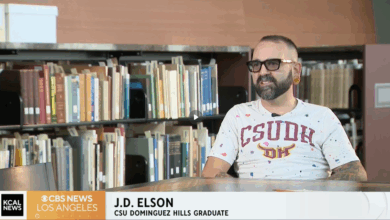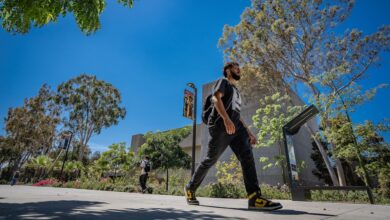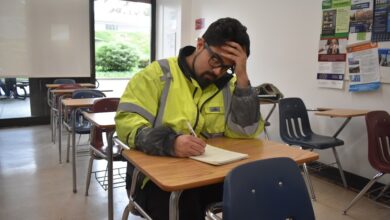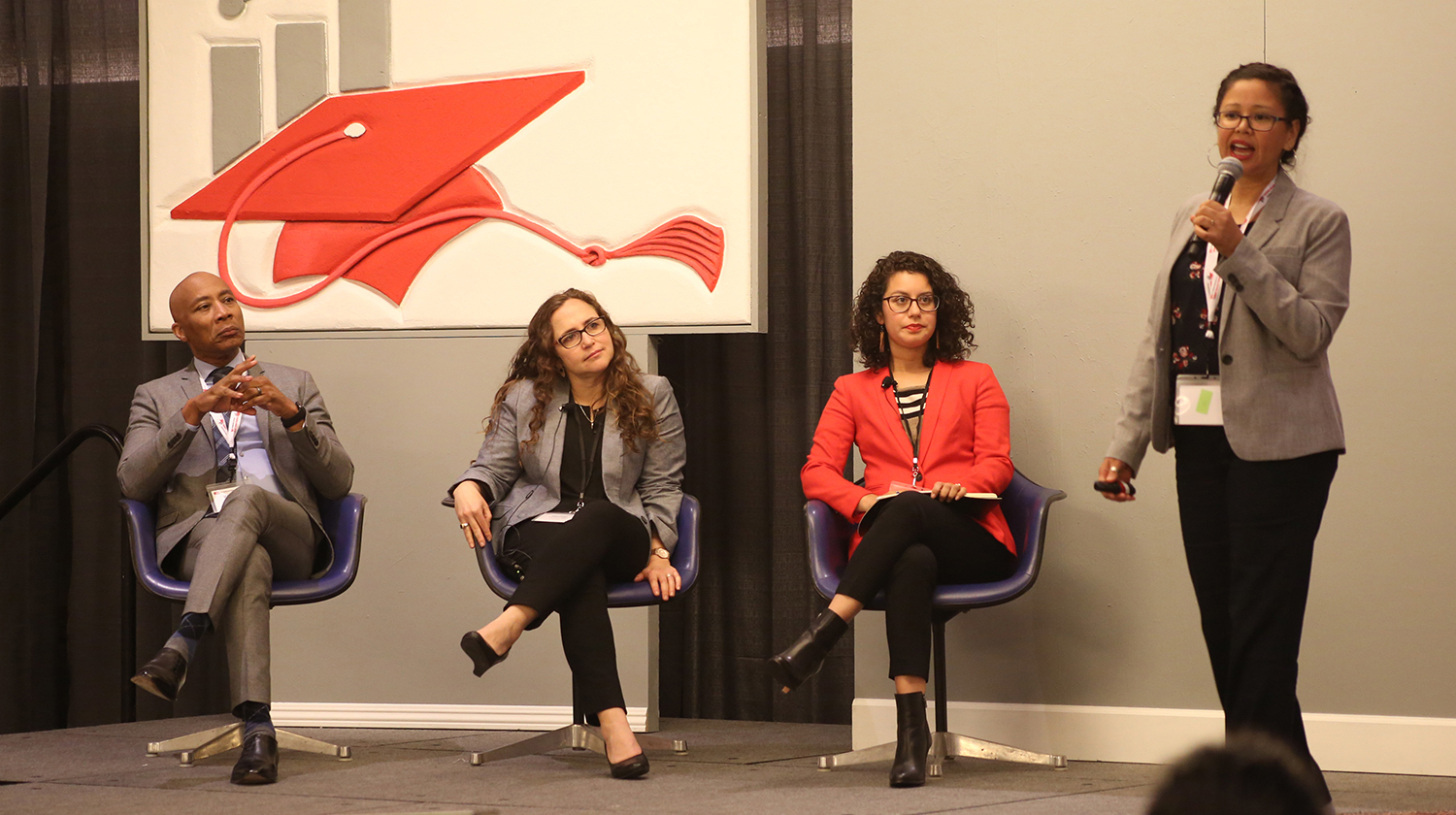Source: EdSource
CSU Dominguez Hills is taking an unusual step to bond its new students – and their wardrobes – to the university campus even though orientation and most fall classes will be online.
Incoming freshmen and transfer students at the California State University campus will first go through an online registration via Zoom. But then they will get a taste of real-world school spirit before classes begin with free swag bags of shirts, visors, caps, markers, pens and academic calendars all bearing the school name and logo. Plans call for possible drive-by distributions on campus, with timed reservations and loadings directly into car trunks, while cheerleaders perform from a safe distance.
 The giveaway at the campus situated in Carson south of Los Angeles illustrates efforts underway by many California colleges to prevent a feared flood of students who initially said they would attend in the fall but ultimately do not enroll because of Covid-19 health fears and instruction changes. In May, the 23-campus CSU system announced that it would mostly offer instruction online this fall, the first large university system to make that decision.
The giveaway at the campus situated in Carson south of Los Angeles illustrates efforts underway by many California colleges to prevent a feared flood of students who initially said they would attend in the fall but ultimately do not enroll because of Covid-19 health fears and instruction changes. In May, the 23-campus CSU system announced that it would mostly offer instruction online this fall, the first large university system to make that decision.
“We want to go the extra mile to ensure students have some connection to the campus and can wear their swag proudly,” said William Franklin, CSU Dominguez Hills vice president for student affairs. Giving out the school attire is “meant to give a sense of belonging and help you know you are coming into a learning space.”
During normal times, colleges see a so-called summer melt of students who accept their admission offer and commit to the school and then decide not to attend. But, with the pandemic pushing many college courses online, as is the case at CSU, U.S. higher education is worried that a significant number of students may take a term off, drop out altogether, or start at a less expensive community college closer to home rather than a four-year university. And schools are starting to ponder the possibility that health concerns and restrictions could last into spring 2021.
If the enrollment decline occurs, it could have significant long term implications for students’ college and career plans as well as for the financial health of schools as campuses could lose important tuition revenues needed to operate and pay faculty and staff salaries.
Colleges and universities are scrambling for ways like the t-shirt giveaway at CSU Dominguez Hills to keep likely freshmen on track to enroll and other students to come back. Beyond virtual tours and large group orientations, parent meetings are also being held online. New students are gathering in small Zoom groups to discuss academic majors and join in personal counseling sessions. Some schools are creating virtual social and cultural life with concerts, video game contests and club meetings.
Jayne Fonash, the president of the National Association for College Admission Counseling (NACAC), said the possibility of a higher than normal summer melt is “a quiet concern everyone is thinking about.” Even if campuses are partly open, some worried parents may forbid students from showing up because of health concerns while, on the other hand, some students may not want to spend a term or even the entire school year online.
As a result, this summer most colleges are upping their online, texting and telephone communications with students about fall learning plans and health precautions they will need to take, Fonash and others say.
Some schools are being more flexible about the deadlines for payments of tuition and other costs and allowing enrollment delays for a semester or more without penalties.
Fonash said the message to students from campuses going mainly online will be: “If this is the institution you want to attend, if this is where you want to get your degree, what is so awful about spending a semester on a virtual platform?”
So far, colleges do not report any drastic fall in enrollments. Until the recent surge in Covid-19 cases, some California universities even reported stronger student interest than last year. At CSU Northridge, for example, as of July 1, 7,043 new undergraduates had registered, which is up by about 1% from the same time last year. Enrollment of continuing students also looks comparable to last year, officials said.
All that could change depending on the health situation in coming weeks
At UC Riverside, the summer melt – the share of students who accept the university’s offer of admission in the spring and then don’t show up in the fall – usually ranges between 14% to 19%, depending on the year. But that now could go as high as 25%, according to Emily Engelschall, interim associate vice-chancellor of enrollment services and director of undergraduate admissions. But the number of students who will enroll in the fall appears close to being on track, in part because the university admitted significantly more students from the backup waiting list than usual, she said.
UC Riverside, like many other campuses, is holding a series of online orientations this summer to prepare students for whatever happens in the fall, whether online or in person. To help encourage participation, UC Riverside has reduced the price of orientation to $65 per student from $270, and dropped the custom of staying overnight in the dorms, according to Ellen Whitehead, interim associate dean for campus life and director of student life. Families accompanying students can attend the online orientation for free this year.
The campus has changed another traditional orientation event. Rather than in-person recruiting to campus clubs, there’s now virtual tabling, where clubs and organizations present themselves in videos. UC Riverside also offers zoom backgrounds, showing scenes of the campus and its mascot, for students to use and to further lock in their identify as “Highlanders,” named after the school’s mascot, a bear wearing a Scottish tam o’shanter cap.
Overall, the goal is to present as much information as possible without seeming to force choices on students, Whitehead explained. “Families have to make tough decisions right now. We can’t tell a family what their priority is in times like this, with families losing jobs and going through struggles,” she said. (Annual tuition for full-time CSU students will remain at $5,742, with no discount for online classes.)
At Cal State Dominguez Hills, where most courses will be online, officials are anticipating a dip from last year’s 6,000 new freshmen and transfer students to about 5,100. But that is being successfully offset by a higher number of continuing students, according to Franklin, the vice president for student affairs. He said the campus will work hard to ensure “those numbers will hold” if the outbreak worsens, he said.
In online orientations, counselors are urging students to set aside what they may have heard about the spring semester’s bumpy switch to online learning. They are stressing that faculty are getting trained much more on how to smoothly run online classes. “We are going to try to give you a really good experience,” Franklin said.
Another message is to talk about “the virtues of staying on track” for higher education, which he said is especially important for the large numbers of his students who are in the first generation in their families to attend college. Dropping out or delaying enrollment will put them behind their goals, he said.
Other colleges across the state are trying previously unthinkable strategies to build a sense of community while the physical campus is mainly shut.
For example, University of La Verne, a Southern California private institution which hopes it can hold a hybrid fall semester with some classes face to face, is offering all incoming freshmen a free online class about Covid-19 this summer. The four-credit course will examine the pandemic’s national impacts on health, politics, economics and social life. So far 165 students have signed up, out of 800 or so expected freshmen. With such a relevant topic, it aims at an early start in students’ “intellectual life” and is “a great way for student to help feel that connection and get a sense of faculty who will be in the classrooms throughout their college careers,” said Mary Aguayo, vice president of strategic enrollment.
California Institute of the Arts (Cal Arts), a private university and conservatory in Santa Clarita, has an online version of its Thursday night open-houses at campus art galleries, theaters and concert spaces. Students can even join online drawing and collaging sessions. The event aims to “build community, share information and keep in touch with new and incoming students over the summer as we await their arrival for what will surely be a memorable and challenging semester,” said campus spokesperson Marylou Ferry.
Sonoma State, a CSU campus near Santa Rosa, is using its new chatbot – an artificial intelligence robot that sends reminders to students via text message to prevent summer melt. Texts include messages about enrollment, financial aid checklist reminders, wellness checks to see how students are feeling and how to get involved on campus if classes are online.
Chico State, like most other CSU campuses, plans to offer only 10% of fall classes in person and cut its dorm population in half. The Northern California university has seen declines in the number of new freshmen and transfer students committed to enrolling in the fall: to about 4,230 total, down about 570 from the number who committed last year. Kim Guanzon, Chico State’s admissions director, said she was “pleasantly surprised” that the dip was not worse given the pandemic and that a large portion of Chico’s students come from other parts of the state. Uncertainty remains since many families are waiting to see what happens with the pandemic surge, she said.
Chico State was the first CSU to waive fees for its online orientation and several others have followed. Chico State also is extending deposit deadlines for transfer students far into the summer. “We’ve got the space, and we are trying to maintain the utmost flexibility. We realize this is a moving, living, breathing pandemic,” Guanzon said.
At the same time, orientation counselors are coaching students about online learning strategies. If students feel uncomfortable with online classes, don’t take the hardest courses this fall, they are saying. In the hope that the pandemic will ease by spring, Guanzon said, “maybe do those classes in-person in the spring.”









